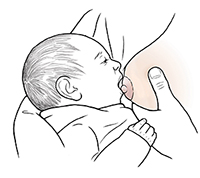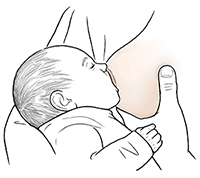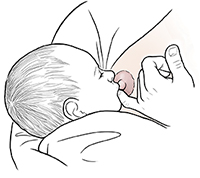Babies use their lips, gums, and tongue to take milk from the breast (suckle). Your baby is born with an instinct for suckling. But it takes time for you and your baby to learn how to breastfeed. There are steps you can take to support your baby’s natural instincts.
How often should I feed my baby?
Nurse your newborn 8 to 12 times every 24 hours. Feed your baby whenever they show signs of hunger. When your baby is hungry, they will appear more awake and might root. Rooting means turning their head toward you when you stroke your baby’s cheek. Your baby might also make a sucking sound or suck on their hand. Crying is a late sign of hunger. If your baby is crying, it may be hard for them to calm down to breastfeed. Infants will often eat at irregular times. But feedings will usually become more regular over time. Sometimes your baby might eat several times in a row (cluster feeding) and then take a break.
If your baby seems sleepy or too fussy to nurse, undress them and place your baby bare against your skin. Don't keep your baby swaddled tightly. This may keep them too sleepy to feed.
Change which breast you offer first with each feeding. For example, if you started nursing on the right side with the last feeding, offer the left side first with this feeding. Always offer the other breast after your baby stops nursing on the first side.
Ask your baby's healthcare provider about waking the baby for feeding. You may need to wake your baby and offer to nurse if it has been 4 hours since your baby's last feeding.
Offering your breast
Hold your breast with your thumb on top and fingers underneath in a loose grip. Gently stroke your nipple on your baby’s lower lip. When you see your baby open their mouth wide, quickly bring the baby to your breast.

Latching on
The way your baby connects with the breast is called the latch. When your baby attaches, you should see more of the darker skin around the nipple (areola) above the baby's upper lip than below the lower lip. The front of your baby's entire body should be touching you. Your baby's nose and chin should be against the breast. Your baby's cheeks should be full and not sinking inward. You should be able to see your baby's lips. They should be slightly flared outward. As your baby suckles, their jaw should open wide. It should not be "munching" as if chewing. Listen for swallowing. It should not hurt when your baby latches on and suckles. If it does, try releasing the latch and starting over.

Releasing the latch
Let your baby nurse until satisfied. In most cases, when your baby is finished nursing, they will let go on their own. This tells you that your baby is done feeding on that breast. You may need to release the latch sooner if you feel pain or for some other reason. To do this, slip your finger into the corner of your baby's mouth. You should feel the suction break. Only when the seal is broken, move your baby off your breast. Don't take the baby off your breast until you've felt a decrease in suction.
